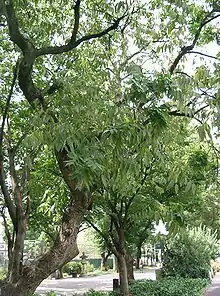| Sapindus mukorossi | |
|---|---|
 | |
| Scientific classification | |
| Kingdom: | Plantae |
| Clade: | Tracheophytes |
| Clade: | Angiosperms |
| Clade: | Eudicots |
| Clade: | Rosids |
| Order: | Sapindales |
| Family: | Sapindaceae |
| Genus: | Sapindus |
| Species: | S. mukorossi |
| Binomial name | |
| Sapindus mukorossi | |
Sapindus mukorossi, commonly known as Indian soapberry, washnut, ritha[2][3][4][5] or Chinese soapberry,[1] is a species of tree in the family Sapindaceae. It is a deciduous tree that grows in the lower foothills and midhills of the Himalayas at altitudes of up to 1,200 metres (4,000 ft).[6][7] It is also native to western coastal Karnataka, Maharashtra, and Goa in India; as well as southern China,[8] and Taiwan as known by its many indigenous peoples.[9] It is tolerant to reasonably poor soil, can be planted around farmers’ homes,[10] and one tree can produce 30 to 35 kilograms (66 to 77 lb) of fruit per year.[11]
Uses
_fruits.jpg.webp)

The value of the tree mostly comes from its fruit, which can be used for many pharmacological and cleansing purposes.[3]
Cleanser/insecticide
The soapnut contains the compound of saponin, which has natural cleansing properties, and therefore the soapnut can be used as a cleanser for hair, skin, and clothing.[6] These saponins are also useful as insecticides, for purposes such as removing head lice off the scalp.[3]
Surfactant
Methods of extracting the maximum amount of oil from existing oil reserves has become a scientific focus in a world that has become dependent on fossil fuels. Researchers have found that the Ritha fruit can be used in an enhanced oil recovery technique.[12] More specifically, Chhetri, Watts, Rahman, and Islam (2009) found that extracts from the soapnut can be used as an organic surfactant to increase the mobility of oil from the fields. In addition, researchers have demonstrated the potential for the soapnut to be used as a natural surfactant for washing arsenic from soils that are rich in iron.[13]
Antimicrobial agent
Due to its saponin content, soapnuts extract may exhibit antibacterial activity.[14][15] In addition, Grzywaczyk et al. (2023) found that saponins from soapnuts can support the effects of the antibiotics nitrofurantoin or furazolidone against several Pseudomonas bacteria.[16]
References
- 1 2 Plummer, J. (2021). "Sapindus mukorossi". IUCN Red List of Threatened Species. 2021: e.T169299323A169300329. doi:10.2305/IUCN.UK.2021-2.RLTS.T169299323A169300329.en. Retrieved 5 August 2023.
- ↑ USDA, NRCS (n.d.). "Sapindus mukorossi". The PLANTS Database (plants.usda.gov). Greensboro, North Carolina: National Plant Data Team. Retrieved 5 November 2015.
- 1 2 3 Upadhyay, A. & Singh, D. K. (2012). "Pharmacological effects of Sapindus mukorossi". Revista do Instituto de Medicina Tropical de São Paulo. 54 (5): 273–280. doi:10.1590/s0036-46652012000500007. PMID 22983291.
- ↑ Orwa C. A., Mutua, K. R., & Jamnadasss R. S. A. (2009) Agroforestree Database: a tree reference and selection guide (version 4.0). Retrieved from http://www.worldagroforestry.org/treedb/AFTPDFS/Sapindus_mukorossi.pdf
- ↑ "Sapindus mukorossi". Germplasm Resources Information Network. Agricultural Research Service, United States Department of Agriculture. Retrieved 14 December 2014.
- 1 2 Sharma, A.; Sati, S. C.; Sati, O.; Sati, D. M.; Kothiyal, S. K. (2011). "Chemical constituents and bio activities of genus Sapindus" (PDF). International Journal of Research in Ayurveda & Pharmacy. 2 (2): 403–409.
- ↑ Sarin, J. L.; Beri, M. L. (1939). "Extraction of saponin from soapnut". Industrial and Engineering Chemistry. 31 (6): 712–713. doi:10.1021/ie50354a012.
- ↑ Sun, C.; Wang, J.; Duan, J.; Zhao, G.; Weng, X.; Jia, L. Association of Fruit and Seed Traits of Sapindus mukorossi Germplasm with Environmental Factors in Southern China. Forests 2017, 8, 491. https://doi.org/10.3390/f8120491
- ↑ Blust, Robert; Trussel, Stephen (2010). "*daqu₂: soapberry - Sapindus mukrossi, S. saponaria". Austronesian Comparative Dictionary. Max Planck Institute for Evolutionary Anthropology. Retrieved 8 November 2022.
- ↑ Forestry Nepal (2014). Sapindus mukorossi. Retrieved from http://www.forestrynepal.org/resources/trees/sapindus-mukorossi
- ↑ Poudel, K. L. (2011). Trade potentiality and ecological analysis of NTFPs in Himalayan Kingdom of Nepal. Himalayan Research Papers Archives, 61 . Retrieved from http://hdl.handle.net/1928/3300
- ↑ Chhetri, A. B.; Watts, K. C.; Rahman, M. S.; Islam, M. R. (2009). "Soapnut extract as a natural surfactant for enhanced oil recovery". Energy Sources, Part A: Recovery, Utilization, and Environmental Effects. 31 (20): 1893–1903. doi:10.1080/15567030802462622. S2CID 95498375.
- ↑ Mukhopadhyay, S.; Hashim, M. A.; Sahu, J. N.; Yusoff, I; Gupta, B. S. (2013). "Comparison of a plant based natural surfactant with SDS for washing of As(V) from Fe rich soil" (PDF). Journal of Environmental Sciences. 25 (11): 2247–2256. doi:10.1016/s1001-0742(12)60295-2. PMID 24552053.
- ↑ Wei, Min-ping; Yu, Hang; Guo, Ya-hui; Cheng, Yu-liang; Xie, Yun-fei; Yao, Wei-rong (2021). "Antibacterial activity of Sapindus saponins against microorganisms related to food hygiene and the synergistic action mode of Sapindoside A and B against Micrococcus luteus in vitro". Food Control. 130: 108337. doi:10.1016/j.foodcont.2021.108337.
- ↑ Ibrahim, Mohammed (2006). "Antimicrobial activity of Sapindus mukorossi and Rheum emodi extracts against H pylori : In vitro and in vivo studies". World Journal of Gastroenterology. 12 (44): 7136–7142. doi:10.3748/wjg.v12.i44.7136. ISSN 1007-9327. PMC 4087774. PMID 17131475.
- ↑ Grzywaczyk, Adam; Smułek, Wojciech; Olejnik, Anna; Guzik, Urszula; Nowak, Agnieszka; Kaczorek, Ewa (2023). "Co-interaction of nitrofuran antibiotics and the saponin-rich extract on gram-negative bacteria and colon epithelial cells". World Journal of Microbiology and Biotechnology. 39 (8): 221. doi:10.1007/s11274-023-03669-2. ISSN 0959-3993. PMC 10241687. PMID 37273071.
![]() Media related to Sapindus mukorossi at Wikimedia Commons
Media related to Sapindus mukorossi at Wikimedia Commons
